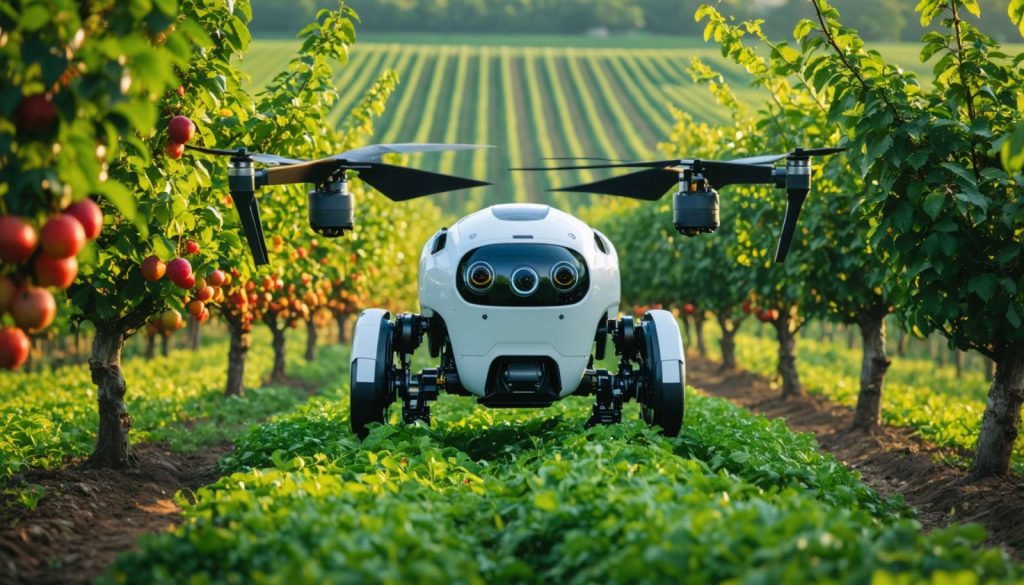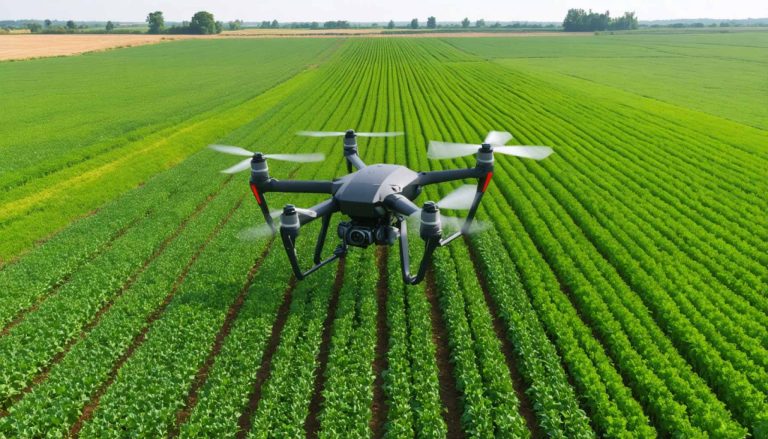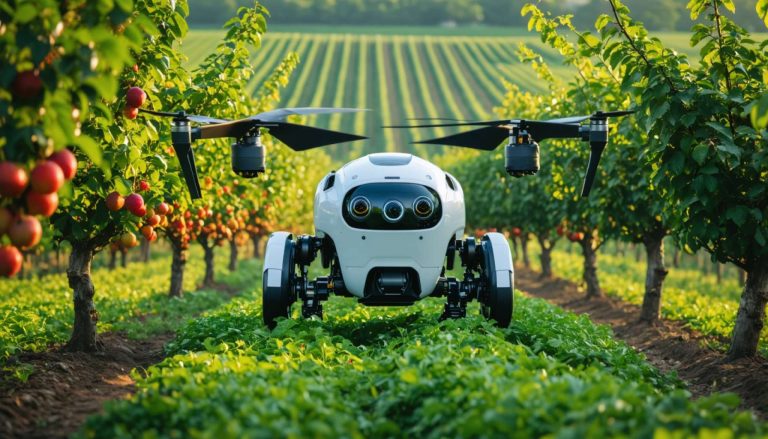
- Artificial intelligence-powered drones by Tevel are transforming global fruit harvesting methods.
- Flying Autonomous Robots (FARs) operate in the US, Italy, and Israel, enhancing harvest precision and reducing waste.
- Equipped with advanced computer vision, these robots identify the perfect ripeness, work tirelessly, and handle fruits gently to avoid bruising.
- Farmers benefit from predictive data, enabling them to strategize harvests efficiently and reduce labor costs by 30%.
- Post-harvest innovations, like UC San Diego’s GRIP-tape gripper, aim to delicately handle fragile produce, though still in development.
- The integration of technology in agriculture prompts discourse on balancing automation with the preservation of rural jobs.
- These advancements represent a sustainable future in farming, challenging us to embrace progress while supporting human ingenuity.
The pastoral idyll of sun-dappled orchards, where seasoned hands deftly pluck ripe fruit from branches, is quietly being reimagined. Across the globe, an agricultural revolution is taking flight—literally. Powered by expertise in artificial intelligence, drones by Tevel are spearheading a seismic shift in how fruit is harvested. Picture autonomous flying robots, weaving effortlessly through grove canopies, their keen artificial eyes assessing each fruit’s perfect moment of ripeness.
These aerial harvesters, aptly named Flying Autonomous Robots (FARs), glide through orchards in the United States, Italy, Israel, and beyond. Their precision is unmatched; equipped with sophisticated computer vision, they ensure only the best fruits are collected, eliminating waste before it even begins. The magic unfolds as these robots work tirelessly around the clock, immune to fatigue and capable of adjusting their gentle grasp to avoid bruising precious produce.
Yet, it’s not just about picking—it’s about predicting. Farmers, armed with treasure troves of data streaming into user-friendly apps, can now forecast harvest outcomes with remarkable accuracy. Every fruit’s size, color, and ripeness become part of a colorful mosaic of information that empowers farmers to strategize more efficiently, cutting labor costs by 30% while elevating the precision of their craft.
But evolution in agritech doesn’t pause at the end of a branch. Innovations extend to how fruit is handled post-harvest. Enter UC San Diego’s GRIP-tape gripper—a prototype brimming with promise yet waiting to take root in commercial farming. Think of steel tape measures gracefully transformed into adaptive fingers, engineered to cradly delicately handle fruits like lemons and tomatoes. Though still a work in progress, this gripper hints at a future where fragility and firmness coexist.
Beyond the immediate, these technologies invite us to ponder deeper questions. Can a balance be struck between advancing automation and preserving vital rural jobs? Innovations like these beckon us to consider: could technology enhance human roles in agriculture rather than replace them? As each robotic advancement unfolds, they compel us to seek methods that leverage human ingenuity alongside automation.
The orchard of tomorrow is no longer a far-fetched fantasy but an unfolding narrative. As these machines whisper through the trees, it’s not just fruit they harvest—it’s the promise of a sustainable, more efficient future. The question remains, are we ready to embrace the fruits of such progress while ensuring that the stewards of our fields are not left behind?
Unlocking the Future of Farming with Drones and AI: Are We Ready for the Revolution?
The Dawn of Drone-Powered Agriculture
The agricultural landscape is undergoing a fundamental shift, with innovations like Tevel’s Flying Autonomous Robots (FARs) leading the charge. These drones utilize advanced AI and computer vision technology to revolutionize the way fruits are harvested across various countries. Yet, beyond the impressive technology lies a web of interconnected challenges and opportunities. Here’s a deeper dive into what this could mean for the future of agriculture.
Additional Facts and Insights
1. Global Reach and Adaptability: Tevel’s drones are not limited to specific climates or types of orchards. Their adaptability allows them to function in diverse environments, enhancing their utility across the U.S., Europe, and beyond.
2. Data-Driven Agriculture: By collecting data on each piece of fruit, farmers can do more than just predict harvest outcomes. This data can be used for long-term planning, trend analysis, and sustainable practice integration. The collected information may also assist in pest control and disease prevention by monitoring crop health in real-time.
3. Economic Impact: While initial adoption costs for these technologies might be high, they promise substantial savings in labor costs—estimated at around 30%—which can significantly enhance the profitability of operations, particularly for larger farms.
4. Sustainability and Environmental Benefits: Automation reduces the need for chemical pesticides, as targeted interventions can be planned based on data-driven insights. This precision agriculture method can decrease waste, help conserve resources, and lead to more sustainable farming practices.
5. Labor Market Transformation: Though automation could affect traditional farming jobs, it opens new roles in technology maintenance, data analysis, and agritech development. This transformation requires upskilling the current workforce or training new personnel.
Market Forecasts & Industry Trends
– Expanding Market Presence: The market for agricultural drones and AI technologies is expected to grow rapidly. According to a report by Research Nester, the agri-tech industry is set to expand at a CAGR of approximately 15% from 2022 to 2030.
– Regulatory Evolution: As drone use increases, we can anticipate evolving regulatory frameworks to ensure safe operation, especially in close proximity to populated areas or other aviation activities.
Pros & Cons Overview
Pros:
– Increased efficiency and productivity
– Substantial reduction in labor costs
– Improved accuracy in harvesting and yield predictions
– Potential for sustainable and environmentally friendly practices
Cons:
– High initial investment cost
– Issues of rural unemployment and job displacement
– Potential privacy concerns with drones collecting data
– Regulatory challenges in different regions
Rising Questions
1. How can small farmers access these innovations?
– Governments and private entities could consider subsidies or financing options to make these technologies more accessible for smallholders.
2. Will automation render traditional farming skills obsolete?
– It is essential to focus on creating training programs that adapt farmers’ skills to the new technological needs, rather than replacing them entirely.
3. Is there a future where humans and robots collaborate?
– Absolutely. The goal is to create symbiotic relationships where robots handle repetitive, labor-intensive tasks, while humans focus on management and creative solutions.
Recommendations and Quick Tips
– Explore Agricultural Innovations: Farmers should regularly assess new tools and technologies to stay competitive.
– Invest in Education and Training: Upskilling in data analysis and technology management can help individuals stay relevant.
– Consider Partnerships: Collaborate with tech companies for pilot projects or research initiatives.
Embrace the wave of agritech evolution but always maintain the human element in agriculture, ensuring technology complements rather than competes with human skills and labor. To learn more about agritech innovations and updates, visit the Tevel website.



